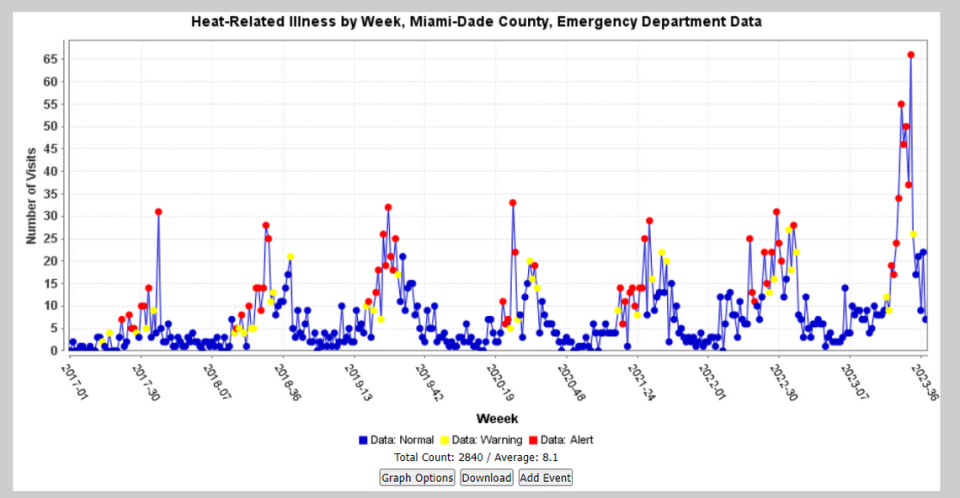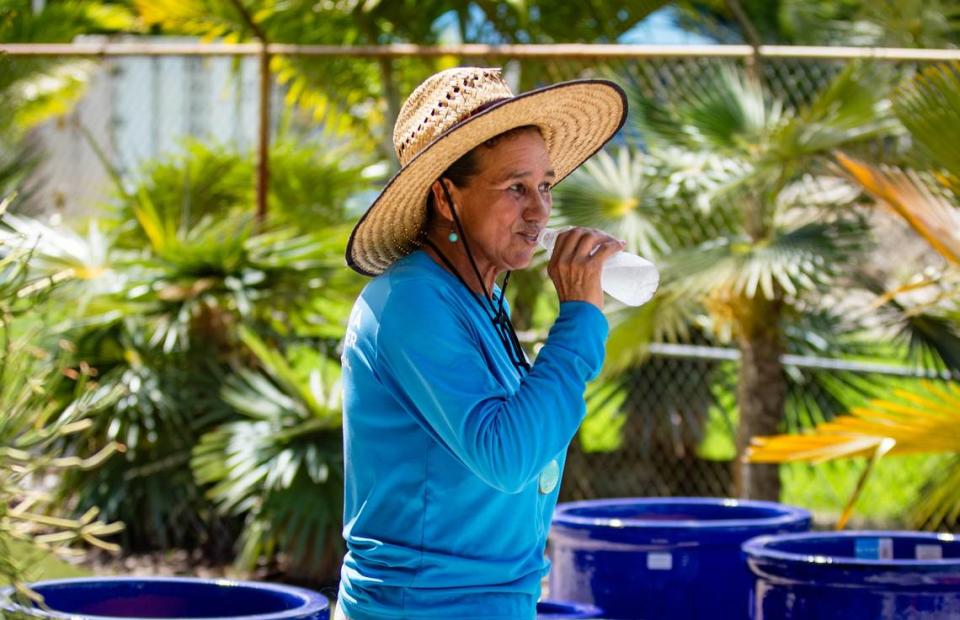Florida has highest number of heat-related illnesses in the nation, new report finds
Florida’s record hot summers can be dangerous for some people and a new study puts numbers to just how dangerous those soaring temperatures can be.
The Sunshine State leads the country in the number of emergency room and hospital visits from heat illness and has more than six million at-risk residents and outdoor workers, according to a report released this week by the Florida Policy Institute.
The state saw more than 26,000 emergency room visits and 5,000 hospitalizations for heat-related illness between 2018 and 2022, according to the most recent U.S. Centers for Disease Control data compiled by the Orlando-based institute, a non-profit organization that researches health, education and other policy issues.
Lives were lost, too. It’s estimated that 150 Florida residents died from heat-related illnesses between 2017 and 2021, ranking sixth in the nation. Arizona, the study found, finished first for heat-related fatalities.
Those numbers, as the Miami Herald also found last year, are likely an under count, with heat’s impact watered down in official statistics. For example, when someone is hospitalized for a condition worsened by heat, their provider typically records only the chronic illness as a cause. The new report also highlights that some Floridians, such as outdoor workers who may fear retaliation from employers for reporting an incident, are also excluded from national statistics.
One thing is clear: Scientists expect temperature trends to continue increasing, driven by climate change. Heat waves this May came earlier than ever before and for most of 2023, temperatures were two degrees above normal. In Miami, there were 46 grueling days of heat index temperatures above 100 last summer.
Despite the record breaking temperatures, efforts to pass worker heat safety laws have failed to date. After a farm work group campaigned for what would have been the nation’s first heat safety measures in Miami-Dade County, Florida lawmakers responded by passing a measure blocking local governments from setting any local protections.
The federal government has since released draft proposal that would include a mandatory 15 minute break every two hours when temperatures exceed 90 degrees heat index that could be finalized as early as this year. At least one major grower in Miami-Dade, Costa Farms, has said it will support the federal rule but also argues that its own policies already offer more protection.
The Florida Policy Institute, a left-leaning policy advocacy group, proposes that state revisit the heat issue, particularly with the potential economic impacts because of the state’s large force of outdoor workers.

“Without common-sense workplace protections, heat-related illness, coupled with Florida’s high uninsured rate, will spell trouble for a growing number of residents,” said Sadaf Knight, CEO of the Florida Policy Institute in a press release.
There is no argument that soaring heat can make people sick. But quantifying the impacts remains a challenge. Last summer, the Florida Department of Health shared with Miami-Dade data showing spikes in emergency room visits during some summer weeks in 2023 that nearly doubled the extremes of previous years. In one week, heat problems brought more than 60 people to the emergency room.
Jane Gilbert, the county’s heat officer, said Miami-Dade County recently started receiving a biweekly email with emergency calls related to heat. But they are also incomplete. The county doesn’t have data for parts of Miami-Dade that have their own fire and emergency response divisions, like the City of Miami and Miami Beach.
Gilbert said calls were made from people of all ages, and spiked on weekends especially when there was a heat advisory issued. So far this summer, there have been reports of dehydration, dizziness and heat stroke.

Who is feeling the heat?
The Institute report also showed that nearly 5.7 million Floridians are “socially vulnerable” to heat, which the CDC defines as situations like having a disability, lacking health insurance, or not having an air-conditioned home.
Nearly half a million people in the state also work outside. Florida’s top outdoor industries are construction, amusement and recreation and landscaping, the report found.
Amusement ride attendants, like at Disney, might be manning a line, working concessions or strapping people into a ride in the sun all day long. Disney’s worker union contract says that employees can refuse dangerous work, and have the right to request information. Even so, two Disney performers passed out this summer after an air conditioner broke backstage.
Farm workers, though not the largest of the outdoor industries, have been one of the most vocal groups in advocating for safe working conditions that include water, rest and shade.
The report pointed out that the Florida Legislature recognized the dangers of heat when it unanimously passed the Zachary Martin Act to protect student-athletes from heat-related illness in 2020. Alexis Tsoukalas, the author of the report, argued that all Floridians deserve the same protections.
Ashley Miznazi is a climate change reporter for the Miami Herald funded by the Lynn and Louis Wolfson II Family Foundation in partnership with Journalism Funding Partners.

